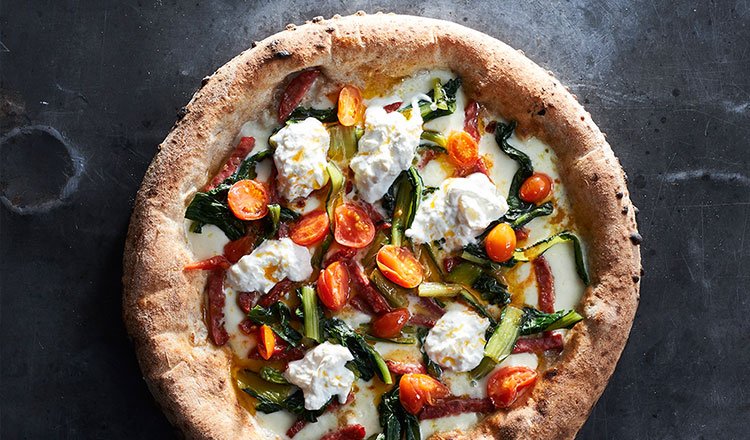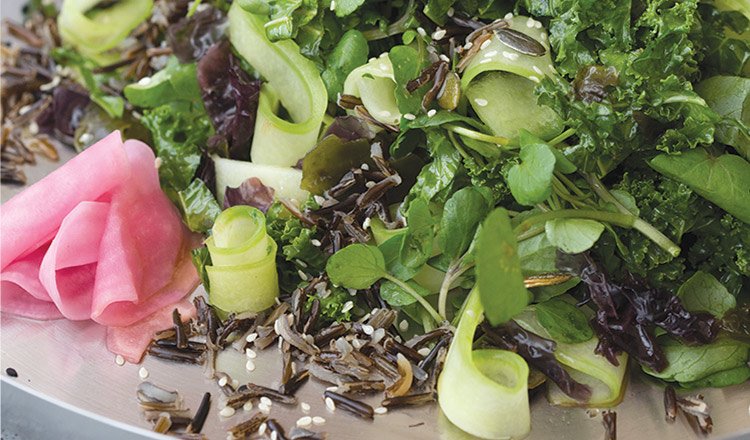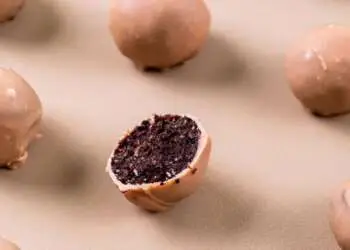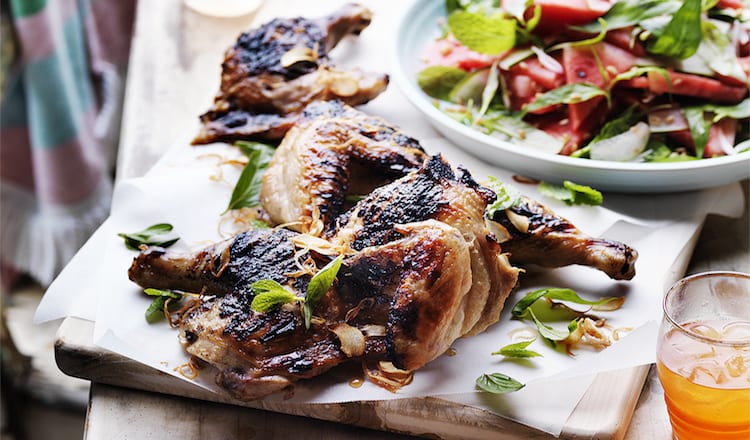Stracciatella is a mixture of fine mozzarella strands mixed with cream. It can be used by itself and is featured as the filling in the extraordinary burrata cheese, originating in Puglia. Chicory is native to the Mediterranean region and is widely used, raw and cooked, in various dishes. It is bitter, but cooking the green leaves removes much of the bitterness.
INGREDIENTS
- 250 g (9 oz) ball of basic pizza dough (see pages 74–77), shaped (see pages 80–83)
- 100 g (3½ oz) fior di latte mozzarella
- 6 slices of good-quality Italian salame, sliced and cut into ‘straws’
- 1 tablespoon grated parmesan cheese
- 4 tablespoons stracciatella cheese
- A handful of confit tomatoes (see page 152)
- 1 tablespoon extra virgin olive oil
- A couple of pinches of freshly ground black pepper
COOKED chicory
- 1 tablespoon salt
- 500 g (1 lb 2 oz) chicory leaves
- 1 tablespoon extra virgin olive oil
- 1 garlic clove, lightly crushed
- Sea salt
METHOD
FOR THE COOKED chicory / Bring 5 litres (175 floz/20 cups) of water to the boil in a pot with a tablespoon of salt added. Plunge in the chicory and submerge with a wooden spoon. After the water returns to the boil, cook the chicory for 3–4 minutes. Drain and let the leaves cool to room temperature. Squeeze as much water out of the leaves as possible. Place the chicory leaves on a board and roughly chop, then put in a bowl and add the olive oil, garlic clove and a little salt. Mix thoroughly. Any leftover chicory can be kept in the refrigerator for up to a week.
FOR THE CONFIT TOMATOES / Preheat the oven to 140°C (275°F). Cut the tomatoes in half, top to bottom. Place in an oven dish so that the tomatoes fill the bottom of the dish in one layer. Add the garlic and thyme. Season with three to four good pinches of salt and three to four turns of freshly ground pepper. Add the olive oil and mix everything carefully with a spoon. Place in the oven for 30–40 minutes. The tomatoes are ready when they’re soft but not falling apart. Any extra tomatoes can be cooled and stored in the refrigerator, in a covered container, with all their cooking juices, for up to 10 days.
TO ASSEMBLE / Place a large tile in your oven for the pizza, then turn the oven up to preheat to full heat (without using any fan-forced function) for at least 20 minutes (see page 89). Thinly slice the mozzarella and scatter evenly, here and there, to top the shaped pizza base, leaving the edges clear to about 3–4 cm (1½ inches). Arrange the salame ‘straws’ on top and sprinkle over the grated parmesan. Place the pizza in the oven for 3–5 minutes until cooked, turning to get an even colour. Once out of the oven, arrange the chopped chicory over the pizza. Dollop the stracciatella on top and distribute the confit tomatoes over the lot. Drizzle with olive oil and add the pepper.
Makes one 30 cm (12 inch) pizza

Basic pizza dough Direct method
The direct method for producing pizza dough is the easiest because all the ingredients are mixed together at about the same time. This is the method that the large majority of pizza-makers use because it’s simple and quick.
For our recipes, however, we extend the maturation phase of the dough in the refrigerator so the
final cooked pizza is easily digested and the flavour of the wheat maximised. Using an unrefined, stoneground whole-wheat (not wholemeal) flour is important because of its rich nutrients and the fact that it means less yeast is needed for fermentation and the maturation phase is thus more effective.
Fresh Yeast Dough
This recipe is for making pizza at home using ‘fresh’ or compressed yeast. Each 250 g (9 oz) ball of dough will make one 30 cm (12 inch) pizza, which feeds one person.
INGREDIENTS
- 1 kg (2 lb 4 oz/6²⁄³ cups) unbleached, stoneground
whole-wheat flour or strong bread flour - 550 ml (19 floz) water at room temperature
- 8 g (¼ oz) fresh (compressed) yeast
- 20 g (¾ oz) sea salt
- 30 ml (1 floz) extra virgin olive oil
METHOD
Place the flour and 500 ml (17 floz/2 cups) of the water in a mixer fitted with a dough hook attachment. Begin mixing on a low speed and keep mixing until the flour has absorbed all the water but is still not smooth. This should take only 3–4 minutes. Stop the mixer and let the dough rest in the bowl for 15–20 minutes.
Meanwhile, dissolve the yeast in the remaining water. Once the dough has rested, turn the mixer on to medium and add the dissolved yeast. Two minutes later, add the salt, mix for 2 minutes and then add the olive oil. Keep mixing until the dough is shiny and homogenous, about 6 minutes. Turn the speed up a little and mix for 2 minutes more.
A good way to check the elasticity is right is to stretch a piece of dough and if it forms a strong, transparent membrane without breaking (similar to blowing a bubble with gum), it is ready. Let the dough sit, covered with plastic wrap, for 30 minutes in winter or 15 minutes in summer. The dough is now ready to be shaped into balls and then rested further in the refrigerator before shaping into discs (see pages 80–83).
Makes 6 pizze (250 g/9 oz each)
Shaping Basic Dough into Balls
- Once the dough is ready to be shaped, take a bench scraper and cut off a piece from the edge.
- The dough will feel soft, airy and malleable. Take the piece of dough at one end and, using both hands, form a ball about 200–250 g (7–9 oz) in size. Work by tucking the folds under the ball so that the top surface is taut and smooth.
- Pinch the dough underneath the formed ball to separate it from the long piece of dough.
- Repeat this procedure to make more balls.
- Roll each ball gently on the work surface to make it even and round.
- Place the balls on a covered non-stick tray. Make sure there is at least one ball width between each ball and the edges of the tray and that the balls don’t touch the cover. Use a fine mist water spray to hydrate the surface of the balls once they are on the tray. Let rise for 1 hour at 20–24°C (68–75°F). After resting, place in a refrigerator for at least 12 hours and up to 18 hours. The balls can sit in the refrigerator at around 4–5°C (39–41°F) for up to 3 days.

Shaping Basic Dough into Bases
- Once the dough has matured and tripled in size, remove from the refrigerator and leave at ambient temperature for 3–4 hours (less in summer and more in winter) before forming the bases. Choose the dough ball to be used and lightly sprinkle some flour on top and along the edges where it touches the surrounding balls.
- Use the bench scraper to separate the dough ball from its neighbours.
- Lift the dough ball from the tray and turn bottom side up, revealing the bubbles.
- Place the dough ball, still bottom side up, on a small mound of flour and turn it over in the flour so that both sides are covered.
- Begin by using your fingers to form the cornice (border) and push the dough out, making the circle larger.
- Once it has doubled in circumference, remove from the flour and place on the work surface.
- Keeping one hand on one side of the base, gently stretch the opposite side with the other hand and lift and slap the dough circle from side to side. This will stretch the gluten in the dough and the base will get larger and larger.
- Once stretched to the desired size (our pizze are around 30 cm/12 inches in diameter), place the base back on the work surface and neaten into a circle. The pizza base is now ready to dress with the toppings and then bake.
Cooking basic dough
Shaped and topped, here you’ll find instructions for cooking your round pizze.
In a wood-fired oven
With the floor temperature between 360–400°C (680–750°F), a pizza will take around 90 seconds to cook. Some pizzaioli cook at temperatures up to 450°C (840°F) and this takes less time. The pizza is put directly on to the oven floor to cook, thereby getting an immediate ‘lift’.
In a domestic oven
My suggestion is to find a large terracotta tile that fits onto your oven rack. Place the rack on the bottom rung of your oven and the tile on top, giving you plenty of room above to manipulate the pizza. Turn to full heat without using any fan-forced function and let the oven run for at least 20 minutes to heat the tile completely. When the pizza is ready, use a floured paddle to take it from the bench on to the tile. Close the oven immediately.
At around 250–280°C (480–535°F) a pizza takes 3–5 minutes to cook, depending on your oven temperature. It will have a crisp, bread-like texture and should be no less delicious than the wood-fired version.

Images and recipes from New Pizza by Stefano Manfredi Murdoch Books, RRP $39.99















